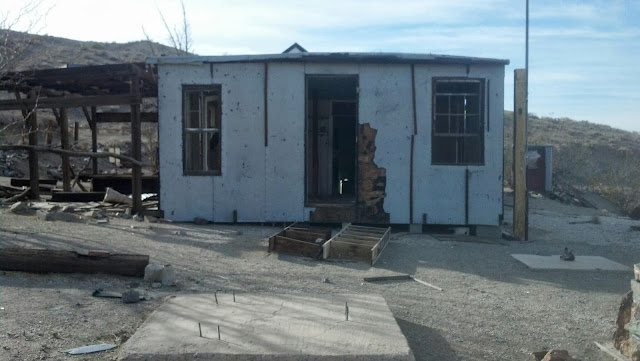Friday, February 28, 2014
Scene from the El Paso Mountains....
Thursday, February 27, 2014
Burro Schmidt Tunnel
After Toni Evelyn Seger died in 2004, her caretaker, David Ayers, left the site.
Since then, there has been no one to guard against vandals, and the Bureau of Land Management has not pursued finding a replacement.
These photographs clearly illustrate the toll that neglect and vandalism have taken on the buildings.
Burro Schmidt Tunnel, today...
This is the entrance to the tunnel, today. I took this photograph nearly two weeks ago.
Photograph by Scott Schwartz.
Wednesday, February 26, 2014
Tuesday, February 25, 2014
El Paso Mountains...
In the heart of the El Paso Mountains back-country, is an area that I call "The Plateau."
We had to drive over some very rocky terrain to get to this particular spot.
Once parked, I launched my Parrot drone. The little aircraft was tossed around by the 20 mph wind, but I hope that the footage gives you a feel for where we were. Click on the link below.
https://www.dropbox.com/s/kgfykkbvppxb6w0/video_20140217_140515.mp4
Monday, February 24, 2014
Parrot AR Drone over Bickel Camp...
To see the footage that was shot from the drone, see this link:
https://www.dropbox.com/s/tvct7jz3ybr71yo/video_20140217_132502.mp4
Thursday, February 20, 2014
El Paso Mountains: Drone Over Bonanza Gulch..
https://www.dropbox.com/s/ww7mkmcbguiy72d/video_20140217_125305.mp4
For more information about Bonanza Gulch, see my earlier post: https://www.blogger.com/blogger.g?blogID=3377803806107825582#editor/target=post;postID=3598222406412095457;onPublishedMenu=allposts;onClosedMenu=allposts;postNum=8;src=postname
Wednesday, February 19, 2014
A drone looks at the Holly Mine, in the El Paso Mountains...
www.elpasomountains.blogspot.com
First discovered by a prospector during the early 1930's, the white pumice ash was mined through the 1950's.
I launched my Parrot AR drone for an aerial survey of the area. See the link below.
https://www.dropbox.com/s/uz3luhjxvtlubzf/video_20140217_104323.mp4
Thursday, February 13, 2014
Coso Wilderness....
One of the places that my old Jeep Cherokee has taken me; the Coso Mountain Range.
www.elpasomountains.blogspot.com
Photograph by Scott Schwartz.
Wednesday, February 12, 2014
Monday, February 10, 2014
Mojave Desert Jeep Traveler...Goler..
Another version of Goler's story has him finding gold while searching for food and water. In this version, food and water were his only interests, and he started a wagon and blacksmith shop upon returning to Los Angeles.
Eventually, Goler led another party in search of the lost gold, but Goler could not locate any known landmarks, and most of the group returned to Los Angeles.
A second expedition set out, but they didn't find anything either.
The spot that was thought to be where Goler initially found gold became known as Goler Gulch. Sometime during the late 1800's a man by the name of Ramsey Cox found a gold nugget that was worth $1900. Naturally, this find attracted scores of prospectors. The prospectors, in turn, attracted businesses which catered to them- including houses of ill-repute.
By 1893, a small town had developed in Goler gulch.
Today, nothing remains except a few crumbling building foundations.
 |
| Goler Gulch ruins. Photograph by Scott Schwartz. |
 |
| Goler Gulch, today. Accessible via four-wheel drive vehicle in the El Paso Mountains. Photograph by Scott Schwartz. |
Friday, February 7, 2014
Traveling through time in my Jeep Cherokee: Goler Gulch...
 |
| Goler Gulch, as surveyed by the author's Jeep Cherokee. Photograph by Scott Schwartz |
would abandon his rifle is any one's guess.
Nonetheless, with his little map and gold nuggets,
Goler was able to convince a few backers to
finance expeditions back to the spot where he
found the gold.
Goler's first attempt to find his gold-strike was an expedition that was led by Grant P. Cuddeback.
Once the party reached the Mojave Desert, it
became apparent that Goler's map matched
scores of canyons and hills. Plus, trying to find a rifle stuck in the ground, in the vastness of the desert was like trying to find a needle in...well, you know. Scouring the area, the group found no trace of Goler's spring, and the angry men grumbled about hanging Goler.
With unshaken confidence in his ability to find his spring and gold nuggets, Goler was able to get another expedition together. This group didn't find anything, either.
According to legend, Goler was spotted throughout the following years, with his burrow, as he searched for gold in the foothills of the El Paso Mountains.
www.elpasomountains.blogspot.com
Thursday, February 6, 2014
Exploration by Jeep Cherokee: California's El Paso Mountains...
Working his way from Death Valley to Los Angeles, a prospector by the name of John Goler supposedly found gold chunks lying on the ground when he stopped at a spring in what is now known as Last Chance Canyon. The year was 1867. According to legend, Goler marked the spot by leaving his rifle stuck in the ground on a hill. Fearing hostile Indians, he picked up a few nuggets and headed to Los Angeles, where he hoped to obtain financing for future expeditions. Why a man who was afraid of hostile Indians would leave his rifle behind, is not clear.
 |
| A remnant of the old Goler town site. Photograph by Scott Schwartz. |
Wednesday, February 5, 2014
My Jeep Time Machine- Bickel Camp..
 |
| Photograph by Scott Schwartz. |
Auxiliary power units ("APU's") are small engines that are installed aboard aircraft in order to power generators. The APU provides power for starting the main engines, and for running electric accessories on the ground.
On the day that this photograph was taken, the caretaker at Bickel Camp told me that this APU came from a B-17 Flying Fortress bomber. Bickel used it as a generator.
For more information about Bickel Camp, go to http://elpasomountains.blogspot.com/2012/01/four-wheeling-into-history-californias.html















